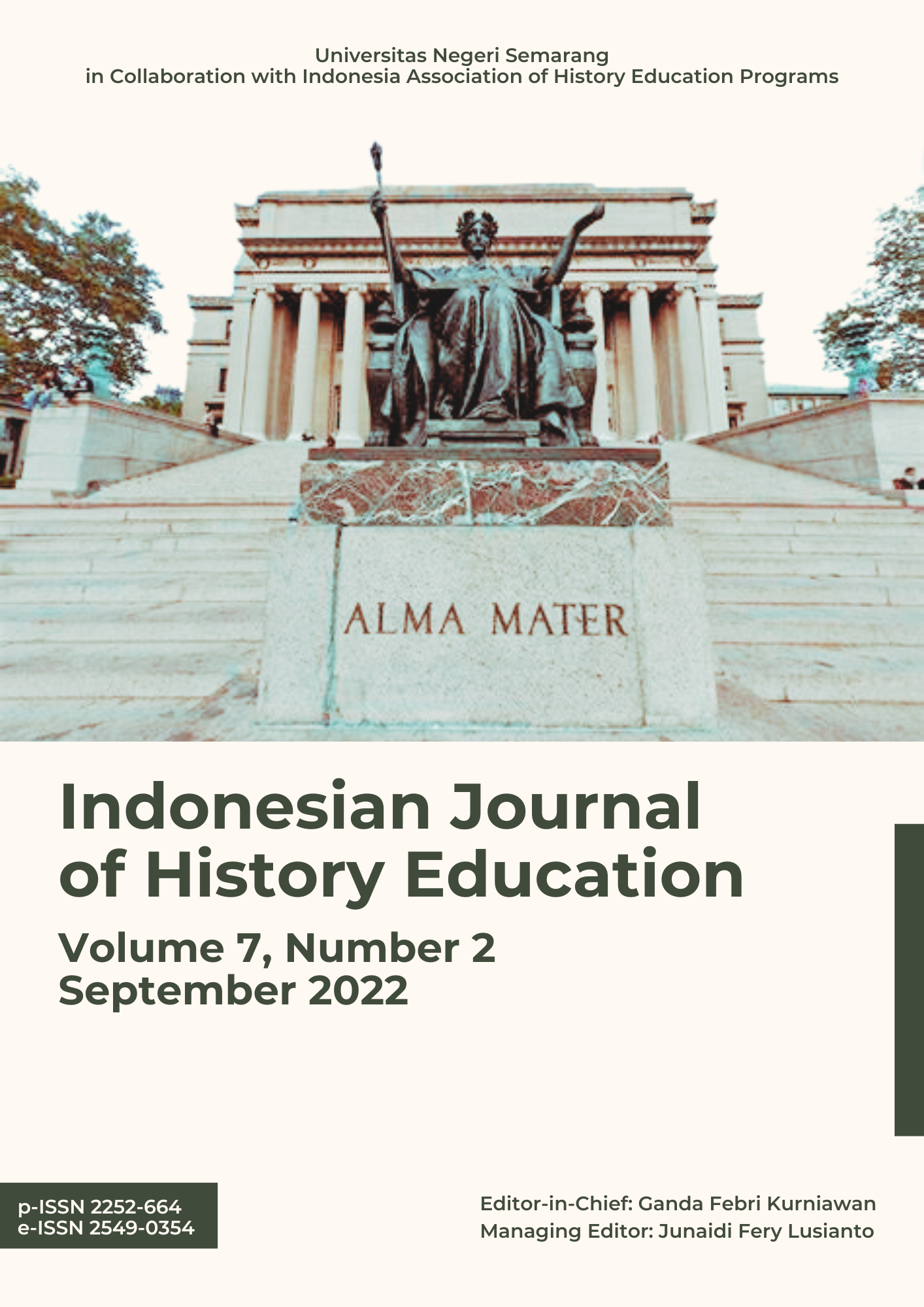History Teachers' Social Construction of History Learning in the 2013 Curriculum in High Schools in Semarang Regency
Abstract
The purpose of this study is to describe the social construction of the history teacher of the 2013 curriculum, the implementation of the 2013 curriculum, and the constraints on implementing the 2013 curriculum in history learning at high schools in Semarang Regency. This research includes qualitative data collection techniques through in-depth interviews, documents, and observations. This study's analysis technique uses data collection, reduction, presentation, and conclusion. This study found that in applying the 2013 curriculum in learning history, the social construction of the history teacher 2013 curriculum in high schools in the Semarang district varied due to the dialectical process teachers experienced through different experiences and influenced by several factors. In implementing the 2013 curriculum on learning, the teacher is adjusted to the characteristics of the school, school facilities, and infrastructure, and the characteristics of students applying the 2013 curriculum present various obstacles. Constraints faced by teachers include student activeness, lack of literacy, use of learning models and methods, and lack of training for teachers to help teachers understand the application of the 2013 curriculum in learning.
References
Berger, P. L dan Thomas L. (2013). Tafsir Sosial Atas Kenyataan: Risalah Tentang Sosiologi Pengetahuan. Terjemahan Hasan Basari. Jakarta : LP3ES.
Budiani, S., Sudarmin, dan Rodia S. (2017). “Evaluasi Implementasi Kurikulum 2013 di Sekolah Pelaksana Mandiriâ€. Dalam Innovative Journal of Curriculum and Educational TechnologyVol. 06. No. 01. Hlm. 45 – 57.
Burhanudin, M. dan Ibnu S. (2018). “Kendala Guru Sejarah Dalam Kurikulum 2013 Menggunakan Pendekatan Saintifik di SMK Negeri 7 Semarangâ€. Dalam Indonesian Journal of History Education. Vol. 06. No. 01 hlm. 89-102.
Halim, M.T., Tri J.K., dan Murwatiningsih. (2015). “Konstruksi Sosial Guru Terhadap Pembelajaran IPS di SD Inpres 6/68 Laburasseng Desa Laburasseng Kecamatan Libureng Kabupaten Bone Sulawesi Selatanâ€. Dalam Journal of Primary Education. Vol. 04. No. 02. Hal. 85–95.
Hamalik, O. (2008). Kurikulum dan Pembelajaran. Jakarta : Bumi Aksara.
Jayusman. (2019). “Pelatihan dan Pendampingan untuk Pembuatan dan Pemanfaatan Multimedia Interaktif Berbasis Saintifik dalam Pembelajaran Sejarah pada MGMP Sejarah Kabupaten Rembangâ€. Dalam Jurnal Panjar Vol. 01. No. 02. Hal. 141-146.
Knoblauch, H. dan Rene W. (2016). “The Common Denominator: The Reception and Impact of Berger and Luckmannâ€s The Social Construction of Reality. Dalam Springer Science and Business Media Dordrecht.
Mulyasa, H. E. (2013). Pengembangan dan Implementasi Kurikulum 2013. Bandung : PT Remaja Rosdakarya.
Pujatama, P. (2014). “Implementasi Kurikulum 2013 Pada Mata Pelajaran IPS di Sekolah Menengah Pertama (Studi Pada Sekolah-Sekolah di Kota Semarang)â€. Dalam Journal of Educational Social Studies Vol. 03. No, 02. Hlm. 38–43.
Purnomo, A., Abdul M., dan Ferani M. (2019). “Pelatihan Pengembangan Perangkat Pembelajaran IPS Berorientasi Pada Perpres Nomor 87 Tahun 2017 Pada Forum Guru Ambarawaâ€. Dalam Jurnal Panjar Vol. 01. No. 02. Hal. 156-159.
Rasyid, H. Joko W, dan Suyahmo. (2015). “Konstruksi Sosial Guru IPS Tentang Pembelajaran IPS di MTS Kecamatan Kota Sumenepâ€. Dalam Journal of Educational Social Studies Vol. 04. No. 01. Hal. 1–7.
Sica, A. (2015). “Social Construction as Fantasy: Reconsidering Peter Berger and Thomas Luckmann’s The Social Construction of Reality After 50 Yearsâ€. Dalam Cultural Sociology Hlm 1-16.
Sugiyono. (2009). Metode Penelitian Kuantitatif, Kualitatif, dan R&D. Bandung: CV Alfabeta.
Sutarman, E. (2014). “Implementasi Guru Sejarah Dalam Menerapkan Kurikulum 2013 di Kelas X di SMA N 1 Rembang Tahun Ajaran 2014/2015â€. Dalam Indonesian Journal of History Education Vol. 03. No. 02. Hlm. 36 -46.
Ulhaq, Z., Tuti N, dan Murni W. (2017). “Pembelajaran Sejarah Berbasis Kurikulum 2013 di SMA Kotamadya Jakarta Timurâ€. Dalam Jurnal Pendidikan Sejarah. Vol. 6 No. 2.
Utomo, C. B. (2015). “Model Pengembangan Perangkat Pembelajaran Sejarah
Berorientasi Metakognitif Jenjang SMAâ€. Dalam Paramita Historical Studies Journal Vol. 25. No. 01. Hal. 135-144.
Wijayati, P. A., Andy S., dan Nyenyep D.P. (2019). “Pemanfaatan Program Colour Note untuk Meningkatkan Kemampuan Menulis Sebagai Upaya Mendukung Budaya Literasi Bagi Guru Sejarah SMA Kabupaten Semarangâ€. Dalam Jurnal Panjar Vol. 01. No. 02. Hal. 163-166.
Copyright (c) 2022 Indonesian Journal of History Education

This work is licensed under a Creative Commons Attribution 4.0 International License.
Copyright Notice
An author who publishes in the Jurnal Indonesian Journal of History Education agrees to the following terms:
- Author retains the copyright and grants the journal the right of first publication of the work simultaneously licensed under the Creative Commons Attribution-ShareAlike 4.0 License that allows others to share the work with an acknowledgement of the work's authorship and initial publication in this journal
- Author is able to enter into separate, additional contractual arrangements for the non-exclusive distribution of the journal's published version of the work (e.g., post it to an institutional repository or publish it in a book) with the acknowledgement of its initial publication in this journal.
- Author is permitted and encouraged to post his/her work online (e.g., in institutional repositories or on their website) prior to and during the submission process, as it can lead to productive exchanges, as well as earlier and greater citation of the published work (See The Effect of Open Access).
Read more about the Creative Commons Attribution-ShareAlike 4.0 Licence here: https://creativecommons.org/licenses/by-sa/4.0/.




